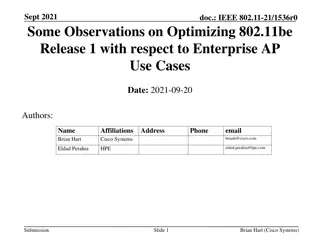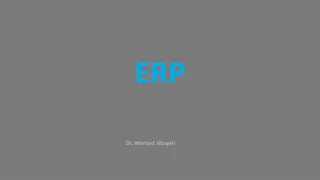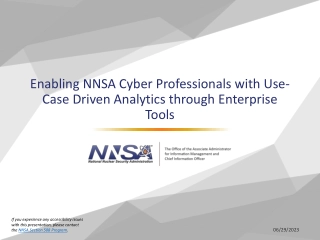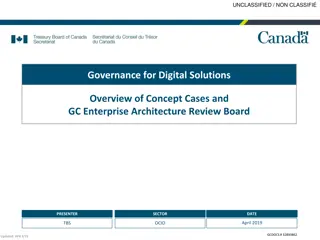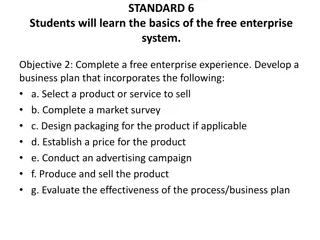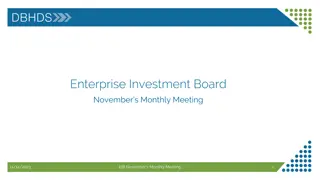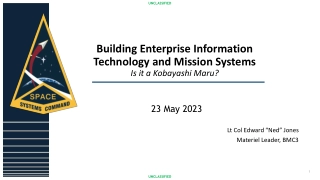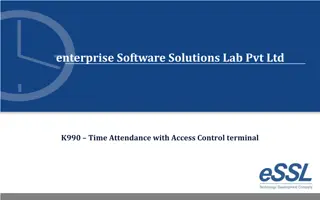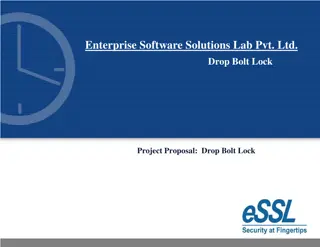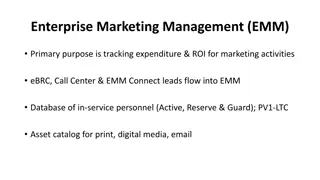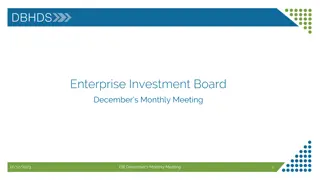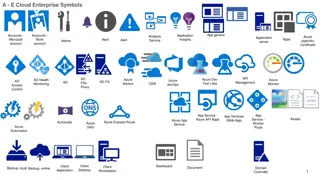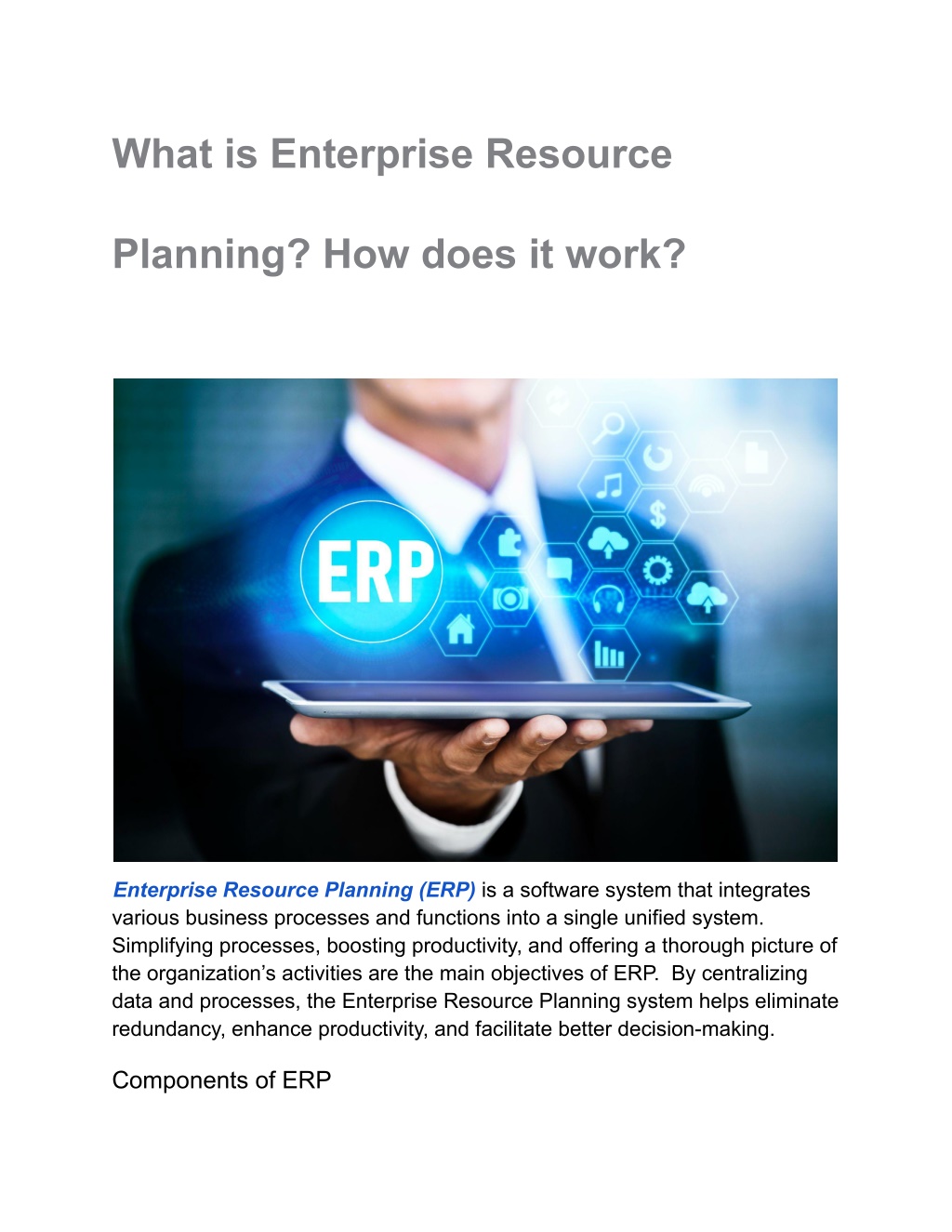
What is Enterprise Resource Planning_ How does it work_
nIn todayu2019s competitive and fast-paced business environment, the need for streamlined processes, efficient management, and real-time data analysis is more important than ever. This is where Enterprise Resource Planning (ERP) comes in, revolutio
Download Presentation

Please find below an Image/Link to download the presentation.
The content on the website is provided AS IS for your information and personal use only. It may not be sold, licensed, or shared on other websites without obtaining consent from the author. Download presentation by click this link. If you encounter any issues during the download, it is possible that the publisher has removed the file from their server.
E N D
Presentation Transcript
What is Enterprise Resource Planning? How does it work? Enterprise Resource Planning (ERP) is a software system that integrates various business processes and functions into a single unified system. Simplifying processes, boosting productivity, and offering a thorough picture of the organization s activities are the main objectives of ERP. By centralizing data and processes, the Enterprise Resource Planning system helps eliminate redundancy, enhance productivity, and facilitate better decision-making. Components of ERP
Enterprise Resource Planning systems typically comprise several key components: 1. Modules: Each module focuses on a specific business function, such as finance, human resources, sales, and supply chain management. Modules can be customized and configured based on the organization s requirements. 2. Central Database: One of the core features of Enterprise Resource Planning is a central database that stores data from various business functions, ensuring data consistency and accuracy across the organization. 3. User Interface: A consistent and user-friendly interface allows employees from different departments to access and interact with the Enterprise Resource Planning system efficiently. Functions of ERP ERP systems are essential to a business for several reasons. Integration: Ensures that all business processes are interconnected, allowing seamless flow of information between departments. Automation: Reduces manual tasks and errors by automating routine business processes, resulting in increased efficiency and productivity. Data Analysis: Provides powerful reporting and analytical tools that help management in making data-driven decisions. Scalability: Supports the growth of the organization by being scalable and adaptable to changing business needs. Benefits of ERP Implementing an Enterprise Resource Planning system offers numerous benefits: Improved Efficiency: Streamlines business processes and reduces operational costs by eliminating redundancies.
Enhanced Collaboration: Facilitates better communication and collaboration across departments through shared information and data. Accurate Reporting: Provides data and insights in real-time, assisting with precise financial reporting and forecasts. Regulatory Compliance: Helps organizations comply with industry regulations and standards by maintaining accurate records and documentation. In summary, Enterprise Resource Planning systems play a critical role in modern business environments by integrating various functions and providing a holistic view of organizational performance. These systems not only improve operational efficiency but also support strategic planning and growth. Core Components of ERP Systems Enterprise Resource Planning (ERP) systems are designed to integrate and streamline various functional areas of an organization. Key components include: Financial Management General Ledger: Central repository for accounting data. Accounts Payable/Receivable: Management of outgoing/incoming payments. Asset Management: Monitoring and controlling of fixed assets.
Budgeting and Forecasting: Instruments for budgeting and forecasting finances. Human Resources Management (HRM) Payroll: Processing employee salaries. Recruitment: Tracking applicants and managing hiring processes. Performance Management: Evaluating employee performance. Employee Records: Database of employee information. Supply Chain Management Inventory Management: Overseeing inventory levels and orders. Order Management: Tracking sales orders from inception to fulfillment. Procurement: Handling purchasing activities. Logistics: Managing transportation and warehousing. Customer Relationship Management (CRM) Sales Automation: Tools to streamline customer interactions. Customer Support: Modules for managing customer service issues. Marketing Automation: Software to automate marketing tasks and workflows. Contact Management: Database for storing customer contact information. Manufacturing Production Planning: Scheduling and managing production activities. Shop Floor Control: Monitoring and controlling shop floor operations. Quality Management: Ensuring products meet quality standards. Bill of Materials (BOM): Listing the components needed to manufacture a product. Project Management Project Planning: Instruments for specifying deadlines and project scope. Resource Management: Allocating and managing project resources. Task Management: Tracking and managing project tasks.
Time and Expense Management: keeping an eye on the time and expenses of the project. Reporting and Analytics Dashboards: Real-time data visualization tools. Advanced Analytics: Reporting tools for data analysis. Business Intelligence: Tools for strategic decision making. Integration and Connectivity APIs: Enabling integration with other software applications. Mobile Access: Allowing access from mobile devices. Data Import/Export: Facilitating data transfer between systems. ERP systems are modular, meaning organizations can implement components individually based on need. Each component plays a crucial role in ensuring comprehensive enterprise management, leading to improved efficiency and productivity. The seamless integration of these core components provides a consolidated view of business operations, enabling informed decision-making and enhanced organizational performance. Enterprise Resource Planning Modules
Enterprise Resource Planning (ERP) systems are composed of various modules designed to handle specific business functions. Each module integrates with the others to provide a comprehensive solution for managing a company s resources, processes, and information. Core Enterprise Resource Planning Modules 1. Financial Management: Manages financial transactions. Handles accounting, budgeting, and forecasting. Provides tools for financial reporting and analysis. 2. Human Resources (HR): Manages employee information. Handles payroll, benefits administration, and recruitment. Tracks employee performance and training. 3. Supply Chain Management (SCM): Oversees the procurement process. Manages inventory control and warehouse operations. Tracks shipments and logistics. 4. Customer Relationship Management (CRM): Manages customer data and interactions. Supports sales, marketing, and customer service activities. Tracks customer behaviors and preferences. 5. Manufacturing: Oversees production planning and scheduling. Tracks work orders and production workflows. Manages quality control and compliance. Additional Enterprise Resource Planning Modules 1. Project Management: Manages project planning and execution. Oversees resource allocation and project costing. Tracks project progress and performance. 2. Sales and Distribution:
Manages order processing and fulfillment. Tracks sales performance and forecasts demand. Handles pricing and discount policies. 3. Enterprise Asset Management (EAM): Manages company assets and maintenance schedules. Tracks asset lifecycle and depreciation. Oversees repair and servicing procedures. 4. Business Intelligence (BI): Provides analytical tools and dashboards. Integrates data from various sources for insights. Supports strategic decision-making. 5. Customer Service Management: Manages service requests and ticketing. Tracks resolution times and customer satisfaction. Integrates with CRM for a seamless experience. Industry-Specific Modules 1. Healthcare: Manages patient records and billing. Handles regulatory compliance and reporting. Oversees medical inventory and procurement. 2. Retail: Manages point of sale (POS) systems. Oversees inventory and supply chain logistics. Tracks customer purchasing habits and preferences. 3. Construction: Manages project bids and contracts. Tracks material usage and project timelines. Oversees compliance with industry standards. Implementing the right combination of these Enterprise Resource Planning modules allows a company to streamline operations, improve efficiency, and gain comprehensive visibility across all aspects of the business.
How Enterprise Resource Planning Software Works Enterprise Resource Planning software unifies different corporate operations into a single system to increase data visibility and expedite procedures within an enterprise. It operates by utilizing a centralized database that supports multiple functions used by different business units. Here are some key mechanisms of how ERP software works: Centralized Database An Enterprise Resource Planning system uses a single database to store all data from multiple business processes. This central repository: Ensures consistency of data across departments. Reduces redundant data entries. Provides a single version of the truth for decision-making. Modular Structure
Enterprise Resource Planning software often comprises numerous modules, each designed for a specific business process. Common modules include: Finance and Accounting: Oversees the general ledger, accounts payable, receivable, and financial transactions. Human Resource Management: Handles recruitment, payroll, employee management, and performance evaluations. Supply Chain Management: oversees logistics, inventory control, and procurement. Customer Relationship Management (CRM): Manages customer interactions, sales pipelines, and customer support. Process Integration Enterprise Resource Planning systems enable the integration of processes by: Automating and streamlining workflows. Ensuring that data flows seamlessly between various departments. Enabling real-time tracking of transactions and operations. Customization and Scalability Enterprise Resource Planning software can be customized to fit the unique needs of an organization. It is scalable, allowing businesses to: Add new modules as they grow. Upgrade functionalities to meet evolving demands. Real-Time Data Access One of the critical features of ERP software is real-time data access, which: Facilitates timely decision-making. Enhances operational efficiency. Provides accurate reporting and analytics.
Security and Compliance ERP systems offer robust security measures to protect sensitive data and ensure compliance with regulations. These include: Role-based access controls. Data encryption. Audit trails. ERP software boosts productivity, maximizes resources, and unites all corporate operations into a single system, improving communication throughout the whole company. Benefits of Implementing ERP Systems Implementing ERP systems offers numerous advantages that can enhance organizational efficiency and competitiveness. These benefits include:
1. Improved Efficiency: An ERP system integrates various business processes across departments, streamlining workflows and minimizing redundancies. Operations become quicker and more effective as a result. 2. Data Accuracy and Consistency: By centralizing data in one system, an ERP ensures that all departments have access to the same, up-to-date information. This reduces errors and inconsistencies. 3. Enhanced Collaboration: With a unified system, employees can collaborate more effectively, sharing information easily and working together seamlessly across departments. 4. Real-Time Information Access: ERP systems provide real-time data access, allowing for quick decision-making. Managers can monitor the current status of operations and make informed decisions based on accurate data. 5. Scalability: Modern ERP systems are scalable, allowing businesses to expand and add new functionalities as they grow. This ensures that the ERP system can evolve with the organization s needs. 6. Regulatory Compliance: ERP systems often include integrated compliance management features, which help organizations adhere to industry regulations and standards by maintaining accurate records and audit trails. 7. Cost Savings: By automating repetitive tasks and improving efficiency, ERP systems can lead to significant cost savings. This includes reduced labor costs and decreased reliance on manual processes. 8. Enhanced Customer Service: Access to customer information and order histories allows for better customer support and service. Employees can quickly address customer inquiries and resolve issues. 9. Supply Chain Management: ERP systems improve supply chain management by providing visibility into inventory levels, supplier performance, and demand forecasts. In addition to reducing shortages and excess situations, this optimizes inventories. 10. Reporting and Analytics: Advanced reporting and analytics capabilities allow businesses to analyze performance metrics and gain insights into their operations. This encourages ongoing development and strategic planning.
11.User Experience: Modern ERP systems typically feature user-friendly interfaces and mobile accessibility, improving user experience and driving adoption across the organization. 12. Improved Financial Management: ERP systems streamline financial operations, from budgeting and forecasting to accounting and payroll. This enhances financial accuracy and supports better financial planning and analysis. Implementing an ERP system can be a transformative step for any organization seeking to improve its operational efficiency and decision-making capabilities. It simplifies complex processes, facilitates better data management, and contributes to overall business growth. Common Challenges in ERP Implementation Implementing an Enterprise Resource Planning (ERP) system presents numerous challenges that organizations must navigate carefully. These difficulties are frequently caused by the size and complexity of ERP systems. High Initial Costs ERP implementation often involves significant initial costs. These expenses cover: Software licensing fees
Hardware upgrades Consulting fees Training programs Resistance to Change Employees might resist adopting new processes and technologies. Resistance can arise due to: Fear of job loss Discomfort with new technology Perceived increase in workload Data Migration Issues Transferring existing data into a new ERP system can be fraught with difficulties. Key issues include: Inconsistent data formats Data quality problems Incomplete data entry Customization and Integration Problems ERP systems frequently need to be customized by organizations to match their particular workflows. Challenges include: High customization costs Complexity in integrating with existing software Risk of customizations affecting system stability Time Constraints ERP implementations often underperform due to tight schedules. Contributing factors include: Underestimating the time required for training
Setting unrealistic project timelines Insufficient time for thorough testing Inadequate Training Insufficient training can lead to poor system utilization. Common training issues encompass: Limited training budgets Lack of user engagement Insufficient hands-on practice Poor Project Management Effective project management is crucial for successful ERP implementation. Common management challenges are: Lack of clear objectives Poor communication Inadequate resource allocation Vendor Selection Issues Choosing the right ERP vendor is critical. Problems in this area include: Contractual disagreements Inadequate post-implementation support Misalignment of vendor offerings with organizational needs Data Security Concerns Because ERP systems concentrate vital data, hackers target them frequently. Security challenges entail: Insufficient security measures Poor data encryption practices Unclear data access policies
Legal and Regulatory Compliance Ensuring the ERP system complies with laws and regulations can be intricate. Compliance challenges include: Understanding specific regulatory requirements Keeping the system updated with changing laws Ensuring audit trails and transparency Successfully navigating these common challenges requires careful planning, resource allocation, and stakeholder involvement. Customization and Integration of ERP Systems Customization and integration are critical components in the deployment and enhancement of Enterprise Resource Planning (ERP) systems, making them more adaptable to specific business needs.
Customization Customization allows businesses to tailor ERP systems to their unique requirements. Key areas for customization include: 1. User Interface (UI): Modifying the system interface to align with user preferences and corporate branding. Enhancing user experience by adjusting layouts and workflows. 2. Business Processes: Updating built-in processes to reflect specific organizational workflows. Creating custom modules to support business operations not initially covered by the basic ERP suite. 3. Reporting: Developing custom reports to meet internal and external reporting requirements. Utilizing business intelligence tools to create data-rich dashboards and analytics. 4. Extensions: Integrating industry-specific features to satisfy niche market demands. Adding functionality through add-ons or plugins tailored to specialized tasks. Integration Integration ensures that the ERP system works seamlessly with other software systems used within the organization, creating a unified technology environment. 1. Data Integration:
Synchronizing data between ERP and other systems to maintain a single source of truth. Utilizing middleware or APIs to facilitate real-time data exchange. 2. Third-Party Applications: Connecting ERP systems with Customer Relationship Management (CRM) tools, e-commerce platforms, and other critical applications. Ensuring seamless interoperability to provide a cohesive operational workflow. 3. Cloud Services: Leveraging cloud-based solutions to enhance accessibility and scalability. Ensuring ERP systems are deployed in hybrid or fully cloud environments for flexibility. 4. Legacy Systems: Linking outdated legacy systems to the ERP to ensure data continuity. Phasing out legacy systems over time while minimizing disruptions. Technical Considerations Technical considerations in customization and integration involve: Security: Putting strong security measures in place to safeguard confidential company information. Ensuring compliance with industry standards and regulations. Scalability: Ensuring the ERP system is scalable to accommodate future business growth.
Employing modular architecture to enable incremental system enhancements. Maintenance: Regular updates and maintenance to keep the ERP system efficient and bug-free. Continuous monitoring and performance tuning to optimize system functionality. By focusing on these aspects, organizations can leverage ERP systems to their full potential, ensuring greater efficiency, adaptability, and alignment with business processes. Key Industries Utilizing ERP Solutions Enterprise Resource Planning (ERP) systems have become invaluable across a multitude of industries due to their capability to integrate various business processes into a unified system. Key industries leveraging ERP solutions include: Manufacturing Supply Chain Management: ERP systems optimize supply chain logistics, ensuring efficient inventory management, procurement, and distribution.
Production Planning: They facilitate real-time visibility into production schedules, resource allocation, and workflow automation. Quality Control: ERP solutions standardize quality checks and compliance reporting, enhancing product consistency and regulatory adherence. Retail Inventory Management: ERP systems maintain optimal stock levels, reducing overstock and stockouts through accurate forecasting. Sales and Order Processing: They streamline sales workflows and automate order processing, ensuring swift transaction handling. Customer Relationship Management (CRM): Retailers benefit from integrated CRM tools for personalized customer interactions and retention strategies. Healthcare Patient Management: ERP systems consolidate patient data, enabling efficient patient scheduling, billing, and care management. Financial Management: They support robust financial operations, including budgeting, billing, and claims processing. Regulatory Compliance: Healthcare institutions leverage ERP to maintain compliance with healthcare standards and regulations. Construction Project Management: ERP solutions provide comprehensive project planning, tracking, and resource management capabilities. Financial Management: They ensure accurate job costing, budgeting, and financial reporting. Human Resources: Construction companies utilize ERP for workforce planning, payroll, and compliance with labor laws. Education Student Information Systems: ERP systems manage student enrollment, grades, attendance, and academic records.
Financial Aid Management: They streamline financial aid processes, including application tracking and disbursement of funds. Human Resources and Payroll: Educational institutions benefit from ERP for faculty and staff administration, payroll, and benefits management. Automotive Production Management: ERP systems enable precise production scheduling, resource optimization, and quality compliance. Inventory Control: They support efficient inventory management of raw materials and finished goods. Supplier Collaboration: Automotive companies use ERP for supplier relationship management and procurement processes. Wholesale and Distribution Order Fulfillment: ERP systems enhance order processing, tracking, and fulfillment accuracy. Warehouse Management: They optimize warehouse operations, including inventory tracking and space utilization. Logistics Management: ERP solutions coordinate logistics and transport management for efficient delivery processes. ERP solutions cater to the unique requirements of these industries, empowering them with tools for improved operational efficiency, data accuracy, and strategic decision-making. Future Trends in ERP Technology
Enterprise Resource Planning (ERP) technology continues to evolve, driven by advances in digital technology and changing business needs. Cutting-edge innovations and new functionalities are expected to transform traditional ERP systems radically: 1. Artificial Intelligence and Machine Learning: Enhanced predictive analytics Improved decision-making processes Automated routine tasks 2. Cloud ERP Solutions: Greater scalability Reduced upfront costs Real-time data access 3. IoT Integration: Real-time monitoring of operational processes Enhanced supply chain management Improved asset tracking 4. Mobile ERP: Increased accessibility for remote workforces Enhanced user experience Real-time decision-making 5. Blockchain Technology: Enhanced security and transparency Streamlined transaction processing Improved compliance tracking 6. Advanced-Data Analytics and Big Data: Deeper insights into business operations Improved forecasting Enhanced customer experience 7. Enhanced User Interfaces and User Experience: More intuitive and engaging interfaces Personalization of dashboards Increased user adoption rates
8. Robotic Process Automation (RPA): Streamlining repetitive tasks Reducing human errors Increasing operational efficiency 9. Hybrid ERP Systems: Combining on-premise and cloud solutions Flexibility in deployment Customizable to specific business needs 10. API Integration for Enhanced Connectivity: Seamless integration with other business applications Improved data synchronization Enhanced process automation It is anticipated that ERP systems will advance in intelligence, adaptability, and usability. Businesses that stay abreast of these trends and adopt the latest ERP technologies are likely to gain a significant competitive advantage, streamline their operations, and enhance overall productivity. Companies will need to continually evaluate their ERP solutions to ensure they are leveraging the latest advancements in technology to meet evolving business demands effectively.
The Value of ERP in Today s Business Environment In the contemporary business climate, ERP systems are not merely operational tools; they are strategic pillars foundational to organizational success. By integrating essential business functions, ERP enables companies to streamline processes, elevate productivity, and gain comprehensive insights into operations. Key Benefits of ERP Systems: Efficiency Improvement: ERPs automate routine tasks, diminishing the need for manual input and reducing the risk of human error. Data Centralization: ERP systems promote accuracy and consistency by combining data from several departments into a single database. Enhanced Reporting: Real-time data access ensures managers have the latest information, aiding in more informed decision-making. Competitive Advantages:
1. Scalability: ERP systems can adapt as companies grow, accommodating new processes, business units, or geographic expansions. 2. Regulatory Compliance: Automatic updates ensure adherence to industry regulations, minimizing legal risks. 3. Customer Satisfaction: Streamlined business operations often result in quicker response times and improved service quality. Financial Impacts: Cost Reduction: By optimizing resource utilization, ERPs can significantly lower operational costs. Investment Justification: The initial financial outlay of an ERP system is often outweighed by long-term savings and efficiency gains. Technological Advancements: Cloud Integration: Cloud-based ERP solutions enhance flexibility, allowing remote access and reducing on-premises hardware needs. Advanced Analytics: Modern ERP systems leverage AI and machine learning to provide predictive insights, facilitating proactive management. Given these multifaceted benefits, the integration of ERP systems is increasingly viewed as indispensable for businesses aiming to maintain agility, enhance performance, and sustain competitive advantage in a technologically evolving marketplace.


